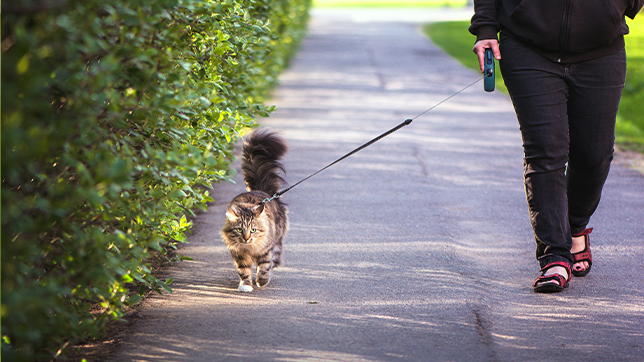20th October 2023
Can you walk a cat?

Cats are infamous for being independent, so, do they enjoy being walked on a lead? Should kittens wear collars or harnesses? Will walking felines form better bonds with their pawrents?
We’ve got all you need to know about walking your cat and how to do it safely if at all.
Preparing to walk your cat
Adventures with your feline friend could become more than just a thought! But, before trying to walk your cat, it’s important to speak to your vet about their individual needs. Your cat may not be a good candidate for walking on a lead.
Collar and harness
Collars aren’t suitable as feisty felines can fidget out of them, so it’s better to use a harness if planning to walk your cat. Always check your cat’s harness fits correctly and is completely comfortable before venturing outside.
Remember: Your kitten should practise strutting around the house on a lead in their fancy, new harness before stepping outside.
Lead
The lead used to walk a cat should be lighter (in weight) and longer than a dog lead. Long leads are better because felines are smaller than canines and they’re more inclined to jump onto things.
Remember: Plenty of praise should help to make walking on the lead a positive experience for your pet. And don’t forget to take cat-friendly treats!
Reasons to walk your cat
Each cat is an individual with their own opinions. Should your feline friend love a challenge, walking might be the way to go! Here are just some reasons you should consider heading out and about with your cat.
Lack of safe outdoor options
Flats and other cityscape homes may not have gardens. Since cats naturally seek outside space, it can feel unfair to keep them indoors.
A walk on the lead seems a simple solution to fulfilling a moggy’s need to enjoy the outside world, without the risk of running into a road.
Part of a recovery plan
There are rare occasions your vet may suggest walking your cat on lead to help with their recovery from an injury or surgery.
Although cats should be kept indoors after surgery, keeping them calm on a lead may limit their range of movement yet still allow them to stretch their legs briefly as a break from cage rest.
However, your vet will let you know if part of your pet’s recovery plan requires them to be walked on a lead. If you’re unsure about any aspect of your feline’s recovery from injury or surgery, contact your vet.
Extra bonding time
Any time spent with your four-legged friend helps to build a strong bond.
By taking your cat outside, they’re likely to appreciate the feel of a fresh breeze, and in turn, your moggy might show a little extra affection to their favourite pawrent!
Reasons not to walk your cat
It’s never fair to force felines to walk on leads, so, if your cat is unhappy while walking on a lead, please stop straight away. Speak to a vet for further advice if you want to take your cat outside but feel walking on a lead isn’t right for them.
Types of territory
The right to roam means moggies might visit any outdoor space in their local area. If your feline feels especially territorial, they may not be happy to cross another cat’s path while out walking.
It’s impossible for us to know which section of the street or park belongs to which neighbourhood cat, making it easier to upset our fussy feline friends!
Protecting their privacy
Many cats feel frightened about facing the outside world. From barking dogs and speeding cars to loud sounds and overwhelming odours, being outdoors can cause timid tabbies to panic while walking on a lead.
Cats love control
We’re all aware that cats see us as their devoted workforce, so putting them on a lead can seriously cramp their style.
If your feline friend prefers paving their own path, they probably won’t want to be walked on a lead, like a dog (gasp!).
Alternatives to walking your cat
For cats who favour their freedom, and who disagree with the lead, many alternatives are available.
Allow felines to follow their instincts
Some cats have a deep-rooted need to get outside and explore.
Although we worry about letting our precious pets outside, there are steps pawrents can take to make it safer to let our cats roam. For example, get them:
- Microchipped.
- Neutered.
- Vaccinated.
- A quick-release collar (with ID tag!).
For specific advice about letting your feline free for the first time, why not visit our guide?
Create an indoor cat paradise
A purrfect place for pets to play is preferable to taking scaredy cats for a walk!
Let your curious kitty enjoy their indoor environment by setting up somewhere for them to:
- Eat (puzzle feeders are always fun!).
- Sharpen their claws.
- Practise hunting behaviours (e.g. stalking toys, jumping, chasing, etc.).
- Climb.
- Rest (preferably up high!).
- Poop in peace.
You can always ask a vet for ideas about entertaining your indoor cat.
